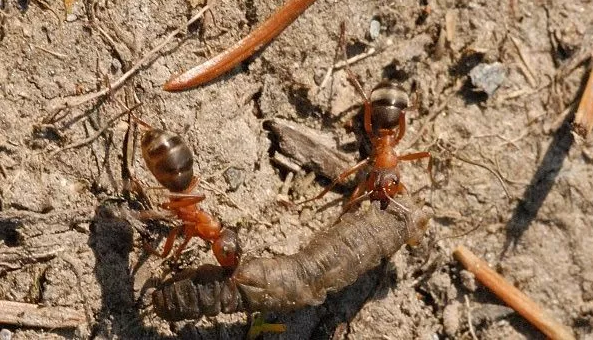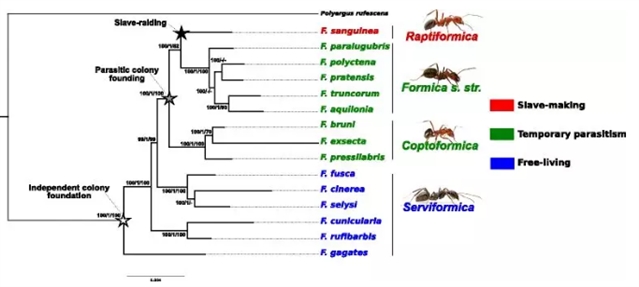论文标题:Phylogenomics of palearctic Formica species suggests a single origin of temporary parasitism and gives insights to the evolutionary pathway toward slave-making behaviour
期刊:BMC Evolutionary Biology
作者:Jonathan Romiguier et al
发表时间: 2018/3/28
数字识别码:10.1186/s12862-018-1159-4
原文链接:https://bmcevolbiol.biomedcentral.com/articles/10.1186/s12862-018-1159-4?utm_source=BMC_blog&utm_medium=Blog&utm_content=DavFal-BMC-BMC_Evolutionary_Biology-Veterinary_Sciences-Global&utm_campaign=BMCS_USG_JUNE2018_Formica_slave_making#Sec1?utm_source=WeChat&utm_medium=Social_media_organic&utm_content=DaiDen-BMC-BMC_Evolutionary_Biology-Biology-China&utm_campaign=BMCS_USG_BSCN_DD_BEB_BLOG
在近期发表于BMC Evolutionary Biology的一篇文章中,研究人员利用系统发育基因组学分析来解密蚁属中蚂蚁间的关系,为奴役行为的进化起源提供建议。他们为这一困扰了几代生物学家甚至达尔文本人的行为提供了一种解释。

血红林蚁(Formica sanguinea)是一种蓄奴的物种,可以侵入其奴役蚁的巢穴,捕捉其中生活的蚂蚁。
无可否认,蚁丘中生命间复杂的社会结构令人着迷,并且蚁属某些物种的奴役行为可作为社会寄生的典型例子。
奴隶制的演化进程吸引着一代又一代的自然科学家,并引发了根植于达尔文“物种起源”理论中的一场讨论。
进化论之父表示,蚁属中的奴役通过所谓的“临时寄生”这一中间步骤逐步演化。 这一假设得到了一些现代研究者的支持,但其他科学家提出了另一种解释,认为寄生蚁群通过几次独立演化而形成。
为了解答这一长达150年的分歧,Jonathan Romiguier与来自洛桑大学、蒙彼利埃、不列颠哥伦比亚省和赫尔辛基的一组研究人员利用现代系统进化基因组学方法,最终揭开了古北区蚁属亚属中的复杂关系。
使用实验和生物信息学相结合的方法,Romiguier和同事们建立了系统发生树来重建四个蚁属亚属的演化过程。根据系统发生树的分支,我们可以追溯古北区蚁属的历史,强调了从自由到奴隶制过程中的关键时间点。

蚁属的分子系统发生
图片来自论文
自由生活的Serviformica位于进化树的基部,这是唯一能够独立形成蚁群的群体,表明蚁属有着独立形成蚁群的自由生活祖先。
沿着进化树,蚁属发生了演化,可以发现一个单独的分支涵盖了其他亚属,包括Coptoformica, Formica s. str.以及存在奴役行为的Raptiformica属。
它们有某些共有的特征,例如丧失了独立建立新蚁群和临时寄生蚁群的能力,这表明它们的亲缘关系很近,它们共同的祖先开始寄生于Serviformica巢中,并将这种能力传给了这三个亚属。
Coptoformica和Formica s. str.亚属也被称为“木蚂蚁”,它们依赖奴役以外的机制来建立新蚁群。他们通常会进行“萌芽”,这是一个新蚁后和工蚁离开并在附近建立新蚁群的过程。这种行 为导致了许多相互连接巢穴并形成超级蚁群,并且被认为是对寒冷栖息地的适应,然而成功建立独立蚁群会受到蚁后高死亡率的限制。在这种情况下,经常观察到巢穴间蚁群的转移。
木蚂蚁可以进行所谓的“临时寄生”,在这种情况下,新蚁后进入Serviformica蚁的巢穴,驱逐和替换原来的蚁后,并利用原巢穴中的工蚁来干活。随着时间的推移,原来的工蚁逐渐被临时寄生蚁后的后代所取代。
随后,Raptiformica除临时寄生之外,还形成了主动奴役的独有特征。这可以从Serviformica巢穴进行季节性的种间抢夺,从而增加工蚁劳动力。在奴役之后,Serviformica工蚁仍然表现得像在自己的蚁群中。
在这种情况下,木蚂蚁典型的蚁群交换可能在领地战争中演变为自私的掠夺,最终成为Raptiformica中观察到的种间奴役行为。
对蚁属演化关系的深层分析形成了一种理论,该理论证实了达尔文最早的假设。
系统发育的分支顺序表明,奴役的进化途径有一个单一起源,然后分几步演化,临时寄生可以被视为自由生活蚂蚁和蓄奴寄生蚁之间的中间步骤。
在讨论这段演化过程的最后,我们可将Romiguier的系统发育树视为“物种起源”中所描述的经典模型的有力支持,它为解答蚂蚁奴役演化过程的世界性难题添加了新证据。
摘要:
Background
The ants of the Formica genus are classical model species in evolutionary biology. In particular, Darwin used Formica as model species to better understand the evolution of slave-making, a parasitic behaviour where workers of another species are stolen to exploit their workforce. In his book “On the Origin of Species” (1859), Darwin first hypothesized that slave-making behaviour in Formica evolved in incremental steps from a free-living ancestor.
Methods
The absence of a well-resolved phylogenetic tree of the genus prevent an assessment of whether relationships among Formica subgenera are compatible with this scenario. In this study, we resolve the relationships among the 4 palearctic Formica subgenera (Formica str. s., Coptoformica, Raptiformica and Serviformica) using a phylogenomic dataset of 945 genes for 16 species.
Results
We provide a reference tree resolving the relationships among the main Formica subgenera with high bootstrap supports.
Discussion
The branching order of our tree suggests that the free-living lifestyle is ancestral in the Formica genus and that parasitic colony founding could have evolved a single time, probably acting as a pre-adaptation to slave-making behaviour.
Conclusion
This phylogenetic tree provides a solid backbone for future evolutionary studies in the Formica genus and slave-making behaviour.
阅读论文原文,请访问
https://bmcevolbiol.biomedcentral.com/articles/10.1186/s12862-018-1159-4?utm_source=BMC_blog&utm_medium=Blog&utm_content=DavFal-BMC-BMC_Evolutionary_Biology-Veterinary_Sciences-Global&utm_campaign=BMCS_USG_JUNE2018_Formica_slave_making#Sec1?utm_source=WeChat&utm_medium=Social_media_organic&utm_content=DaiDen-BMC-BMC_Evolutionary_Biology-Biology-China&utm_campaign=BMCS_USG_BSCN_DD_BEB_BLOG
期刊介绍:BMC Evolutionary Biologyis an open access, peer-reviewed journal that considers articles on all aspects of molecular and non-molecular evolution of all organisms, as well as phylogenetics and palaeontology.
2016 Journal Metrics
Citation Impact
3.221 - 2-year Impact Factor
3.628 - 5-year Impact Factor
1.266 - Source Normalized Impact per Paper (SNIP)
(来源:科学网)
特别声明:本文转载仅仅是出于传播信息的需要,并不意味着代表本网站观点或证实其内容的真实性;如其他媒体、网站或个人从本网站转载使用,须保留本网站注明的“来源”,并自负版权等法律责任;作者如果不希望被转载或者联系转载稿费等事宜,请与我们接洽。